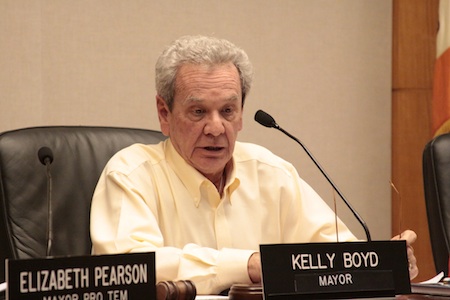 Laguna Beach Mayor Kelly Boyd’s quest to put some teeth into the city’s view ordinance will get its first hearing next week at the City Council meeting on Tuesday.
Laguna Beach Mayor Kelly Boyd’s quest to put some teeth into the city’s view ordinance will get its first hearing next week at the City Council meeting on Tuesday.
In the upcoming year, he and his colleagues will also consider advancing the long-debated Village Entrance project and address parking and public transportation concerns, Boyd said during remarks at the Laguna Canyon Conservancy’s meeting Monday.
Boyd raised a passionate plea to improve the city’s current view preservation ordinance, which he said, “now has no teeth in it whatsoever” and often pits neighbor against neighbor.
“Hopefully something will take place over the next few months that will be good for everybody,” he said.
The city’s current View Preservation Ordinance dictates that residents may file a view claim, along with its $630 filing fee and eight copies of required documentation, only after direct negotiations with neighbors about the offending foliage have failed.
City staff would then contact the foliage owner and suggest a voluntary mediation. If mediation yields no results, the resident may pursue arbitration, also voluntary. Failing a resolution through arbitration, they can pursue a civil action, all at their own expense.
The city’s view preservation guide says the ordinance “does not guarantee that any particular view remediation action will be implemented,” but establishes procedures and encourages cooperation.
Residents in coastal towns have long battled this issue, often unsatisfactorily. Rancho Palos Verdes notably passed one of the state’s first view-protection ordinances in 1989. Local residents cited the success of Rancho Palos Verdes’ law in recent letters to this paper.
Like Laguna’s ordinance, Palos Verdes’ ordinance requires the property owner first attempt resolution on their own. But the likeness ends there. While Laguna’s ordinance refers to the preservation of views and sunlight and discourages damage to vegetation, RPV’s ordinance refers to views as “unique and irreplaceable assets to the city.” After attempting direct negotiations with neighbors, it gives property owners the right to apply for a View Restoration Permit. Instead of promoting voluntary mediation, it empowers the planning commission to review the situation, visit the properties, hold a public hearing, and ultimately either deny or approve the application. In the event of approval, the applicant pays for the proposed alterations and the resulting view is then documented with photographs for future reference.
One Laguna Beach resident, who declined to be identified to avoid conflict with neighbors, described moving from a previous home in Laguna after an unpleasant and ultimately failed effort to resolve a blocked view with his neighbor. Now the foliage of a current neighbor threatens the view he enjoyed when relocating, but he feels he lacks recourse absent a city ordinance that is “totally enforceable.”
Boyd also discussed the Village Entrance project, acknowledging community support for the concept. Even so, he cautioned that figuring out its financing and agreeing on its details remain to be resolved.
The final environmental impact report for the project was certified in June 2011 by the planning commission, said John Montgomery, the city’s director of community development. He said staff prepared options and is discussing them with a council subcommittee, Councilmembers Toni Iseman and Elizabeth Pearson.
The completion of the EIR did establish basic parameters for a parking structure integrated into the hillside and a linear park along Laguna Canyon Road, which would replace surface parking, maintenance areas and existing metal buildings used by the city’s public works and water quality departments, Montgomery said. He said the EIR allowed for a maximum-sized parking structure of up to five levels and 667 spaces. The work ahead involves ironing out specifics.
In a separate interview, Iseman admitted that she and Pearson face tough decisions in fine-tuning the project. “The village entrance means different things to different people. For some it’s about making the entrance to town as beautiful as the rest; for others, it’s a path connecting the downtown with the festivals. For some it’s a park with a sculpture garden, and for many it’s parking, parking, parking. Our job is to blend all those things.”
During his remarks on Monday, Boyd also suggested the possibility of expanding the city’s $800,000 summer trolley to year-round service, noting the need to explore to options to offset potentially higher costs.
Responding to a question from the audience, Boyd nixed the idea of raising taxes to pay for an expanded trolley line, though he mentioned hearing from constituents willing to pay for weekend rides.
Boyd also said that though the city has funded and pushed for completion of the undergrounding of telephone poles along Laguna Canyon Road to Big Bend, Edison has delayed the project.




